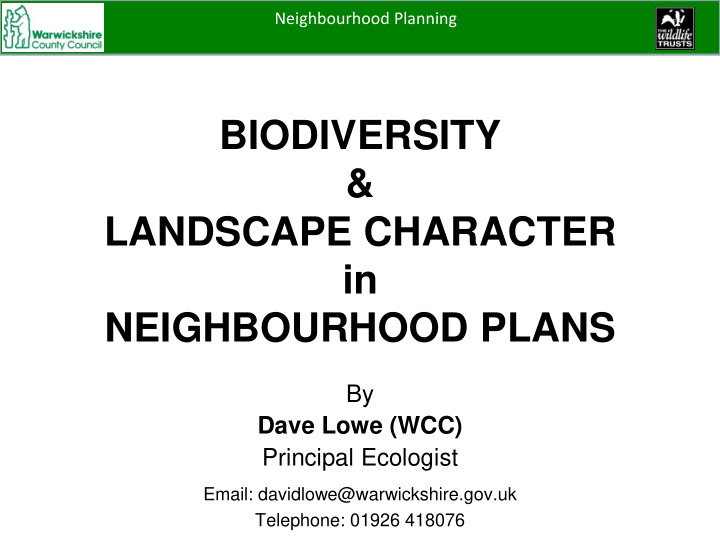



Neighbourhood Planning BIODIVERSITY & LANDSCAPE CHARACTER in NEIGHBOURHOOD PLANS By Dave Lowe (WCC) Principal Ecologist Email: davidlowe@warwickshire.gov.uk Telephone: 01926 418076
Neighbourhood Planning Neighbourhood Plans Natural England
Neighbourhood Planning Neighbourhood Plans
Neighbourhood Planning Natural Environment and Rural Communities Act October 2006 BIODIVERSITY DUTY
Neighbourhood Planning PARISH PLANS Stimulating and securing resources • Successful funding bids; • new income for the parish; • improved facilities & community buildings; • joint projects between neighbouring parishes & towns; The most visible and concrete responses to the Parish Plan process can be seen in the burgeoning of new projects, often accompanied by successful funding applications. Parishes are reporting numerous successful bids for funds that they attribute to the evidence collected for the Parish Plan – both in identifying potential projects and in constructing applications for funds. One Rural Community Council estimates that Parish Plans have generated more than £200,000 in support for projects, covering two district council areas during a 4-5 month period. Projects vary from small grants to renew footpaths or bus shelters, to the common theme of providing play areas and, in one case, a major enterprise to launch a community shop. In this example the parish included the parish plan as part of its business plan. Funders included local businesses, local authorities, national firms, charities and central government.
Neighbourhood Planning Finding solutions to these problems is often difficult as one size rarely fits all. But a Parish Plan can help. By taking a holistic view of a community and its surrounding environment it provides an opportunity to find local solutions to local problems. For example, it could: • identify a redundant farm building that might be developed into workshops for a new local business; • encourage a local farmer or producer to sell their produce in the local shop or to local pubs, hotels and restaurants; • persuade a local landowner to donate a parcel of land for a children’s playing field or local nature reserve; • develop and market an area for tourism; • provide support for the increasing numbers of people working from home, e.g. by building telecottages; • support environmental conservation measures, such as protection of wildflower meadows. The character of the countryside around a village is an integral part of its identity. It should be managed in a way that takes into account its aesthetic and economic importance to the village. Parish Plans - Guidance for parish and town councils 2004, Countryside Agency
Neighbourhood Planning
Neighbourhood Planning
Neighbourhood Planning
Neighbourhood Planning Neighbourhood Planning So that’s that You know what you are doing Thanks for Listening and Good Luck
Neighbourhood Planning Oh Alright Here’s a bit More!
Neighbourhood Planning Neighbourhood Planning I have too many slides for NPPF, so … Suggestion: is to skip to condition 2 as the Local Plan must also have regard to the NPPF
Neighbourhood Planning Neighbourhood Planning Stratford-on-Avon District Council Vision Strategic Objectives
Neighbourhood Planning
Neighbourhood Planning
Neighbourhood Planning Green Infrastructure Strategy Biodiversity – Part A Vision A Warwickshire, Coventry and Solihull where wildlife thrives alongside humans within a resilient landscape; where land and buildings are managed positively for biodiversity, and where biodiversity enhancements are embedded into development, contributing to the extension and joining up of existing biodiversity assets. Recommendation 1 The aim of the sub-regional GI Strategy is to safeguard all GI Biodiversity Assets. Recommendation 2 The aim of the sub-regional GI Strategy is to fulfil two priorities for each of the woodland, grassland and wetland habitat categories: Priority 1) - Connect together individual sub-regional GI Biodiversity assets within their core areas to form large functional clusters. Priority 2) – Connect the Core Areas together [where Priority 1 has been achieved]. Recommendation 3 An additional aim is to create either new Core Areas large enough to function independently as an individual site or a functional cluster of larger and smaller sites where there is a distinct local need or deficiency in a habitat category. http://heritage.warwickshire.gov.uk/files/2013/06/WCS_Sub_Reg_GI_Strategy.pdf
Neighbourhood Planning Landscape – Part A Too many recommendations to cut and paste
Neighbourhood Planning Neighbourhood Planning Warks CC has – Species Information Warks CC and Warks WT has – Sites – Habitat Data Warks CC has – Landscape Character Area mapping All the things you need to prepare your plan…
Neighbourhood Planning Evidence - Data • Habitat Biodiversity Audit Phase 1 habitat survey of the sub region field-by-field boundary-by-boundary Phase 1 - Polygon Phase 1 - Linear Accurate Data since 2001 20% resurveyed annually Completely refreshed Dataset every 5 years
Neighbourhood Planning Warwickshire strategic areas To target restoration and creation of new core areas
Neighbourhood Planning Connectivity Mapping
Neighbourhood Planning Distinctiveness Mapping
Neighbourhood Planning Local Sites (County Importance)
Neighbourhood Planning Species
Neighbourhood Planning Landscape Assessment
Neighbourhood Planning We want to make this information available to you. We unfortunately cannot do this for free! Request Landscape Historic Biodiversity Env. Data only £100 £100 £200 DRAFT Data + interpretation report £200 £200 £300 Data + interpretation report + £500 £500 £500 workshop £1500 a Full Service ( includes further £1000 £1000 meetings, recommendations and policies formation ) a Landscape Assessments are necessary for the Full Service option including employing an external specialist Notes: All costs (unless stated) use existing data only Ecological surveys can be quoted for separately – ensures up-to-date data (circa. +£2000) All costs are based on full-cost recovery (aka not-for-profit)
Recommend
More recommend